Ocelots and Jaguars Moving North
Posted by: Loren Coleman on July 28th, 2010
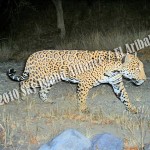
The known ranges of South and Middle American cats are changing. Trailcams are proving it.
Recent records of the ocelot (Leopardus pardalis) are indicating they are being newly seen in northern Mexico and in Arizona. There is evidence that they are extending their range much farther north than in past years.
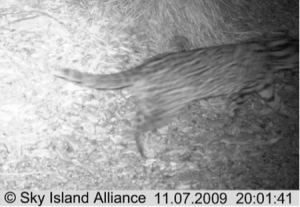
Remote cameras captured the image of an ocelot, a rare tropical cat, in Cochise County, Arizona. Sky Island Alliance, a Tucson-based regional conservation organization, recently photographed the cat while participating in the Witness for Wildlife program, which is supported by the Freedom to Roam Coalition and Patagonia, the outdoor clothing company.
Sky Island Alliance sets remote cameras to unobtrusively observe wildlife and assess wildlife corridors in Arizona’s Sky Island region. Last week, volunteer citizen naturalists participating in the Witness for Wildlife program retrieved images from one of the remote cameras in Cochise County. The image of the ocelot was dated November 7, 2009.
Taken by a remote camera, this remarkable photograph is the first verifiable record of this elusive wild feline alive in Arizona. Although a small number of ocelots live in south Texas, ocelots have never before been recorded alive in Arizona. Additionally, this record from Arizona places ocelots over 200 miles north in latitude from where they are found in Texas.
Sources: Sky Alliance, Backpacker, and Cleanest Line.
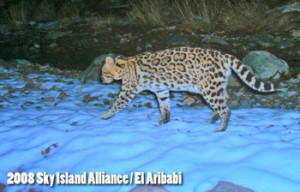
Ocelot in the snow, Sonora, Mexico.
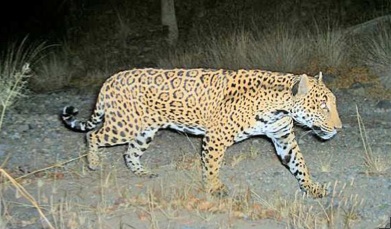
Furthermore, jaguar (Panthera onca) sightings in northern Mexico are occurring too (credit Sky Island Alliance).
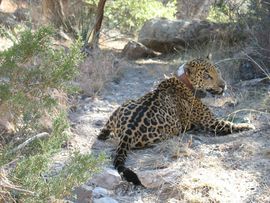
A collared jaguar nicknamed Macho B is seen in this February 2009 photo provided by the Arizona Game and Fish Department. On Feb. 18, 2009, Macho B, who has been documented by tracking cameras since 1996, was inadvertently snared by an Arizona Game and Fish Department trap. The jaguar later died in another trapping incident. (Photo: Arizona Game and Fish Department)
About Loren Coleman
Loren Coleman is one of the world’s leading cryptozoologists, some say “the” leading living cryptozoologist. Certainly, he is acknowledged as the current living American researcher and writer who has most popularized cryptozoology in the late 20th and early 21st centuries.
Starting his fieldwork and investigations in 1960, after traveling and trekking extensively in pursuit of cryptozoological mysteries, Coleman began writing to share his experiences in 1969. An honorary member of Ivan T. Sanderson’s Society for the Investigation of the Unexplained in the 1970s, Coleman has been bestowed with similar honorary memberships of the North Idaho College Cryptozoology Club in 1983, and in subsequent years, that of the British Columbia Scientific Cryptozoology Club, CryptoSafari International, and other international organizations. He was also a Life Member and Benefactor of the International Society of Cryptozoology (now-defunct).
Loren Coleman’s daily blog, as a member of the Cryptomundo Team, served as an ongoing avenue of communication for the ever-growing body of cryptozoo news from 2005 through 2013. He returned as an infrequent contributor beginning Halloween week of 2015.
Coleman is the founder in 2003, and current director of the International Cryptozoology Museum in Portland, Maine.










Killing Macho B was a bad choice although he was probably very aged. If they didn’t kill him and let nature take its course, he would have lived longer and have been living proof, which i certainly think is better than Non-living proof!
Hmmm…interesting. I would say that the ‘known ranges’ of jaguars, ocelots and other south/central american cats, and other creatures for that matter, is based on a relatively small slice of relatively recent history.
Furthermore, our understanding of what the natural world of the Americas looked like in pre-columbian times is frequently and increasingly found to be filled with preconceived notions having more to do with the closely held myth that aside from a few retiring tribes of hunter gatherers, the new world was basically and conveniently un-occupied. Archaeology is revealing that the Americas were far more populated with well organized and mostly sedentary populations who had long ago reduced the original wild inventory and that the vast herds, flocks, and aggregations of wild game was at least partly the result of being no-longer constrained by the numerous indigenous populatons who had vanished as a result of contact with european diseases.
Now, for the first time in a long time, people no longer really live in small villages surrounded by nature which they use for food, but instead we congregate in dense urban landscapes and when we travel into nature it’s along well established routes, roads and highways. Our populatons of wild animals are returning, including prey animals, and consequently their natural predators.
On the first floor of the Museum of Natural History at Dallas’ Fair Park, there are wonderful displays of animals (taxidermied) in replica natural habitats. The mammals represented include a grizzly, a jaguar, a wolf and elk.
Amazingly, all of the animals on the first floor, including the ones mentioned, were killed, one time or another, in the state of Texas. Amazing because grizzlies, jaguars, wolves and elks are no longer native to the Lone Star state.
That’s great news. I hope that someday there will be a breeding population of jaguars in the southwest again.
Dogu4- That is an interesting observation you made and very true in many areas around the world. In Japan for instance, we are experiencing a veritable exodus of people leaving the countryside in favor of dense, urban areas. Many rural areas have experienced sharp drops in population as younger generations begin to prefer city life. Good news for wildlife in most cases.
I would also add that many areas are experiencing a sort of “corridor” effect. You have areas of privately owned land that interconnect together and sometimes are adjacent even with national parks to form a sort of “corridor” for wildlife to move and migrate through. This allows animals to spread out and move through areas that may have been isolated from them otherwise and allows animals to move through otherwise populated areas. There is a wide range of wildlife that make use of corridors of this sort and animals some areas heavily rely on these to move from place to place.
It would not be entirely far fetched for animals with large ranges such as big cats, to wander through these corridors and wind up far from where they are expected to be.